4.1 Einschulung und Schulformen

Lektionsüberblick
1) Die Schulsysteme
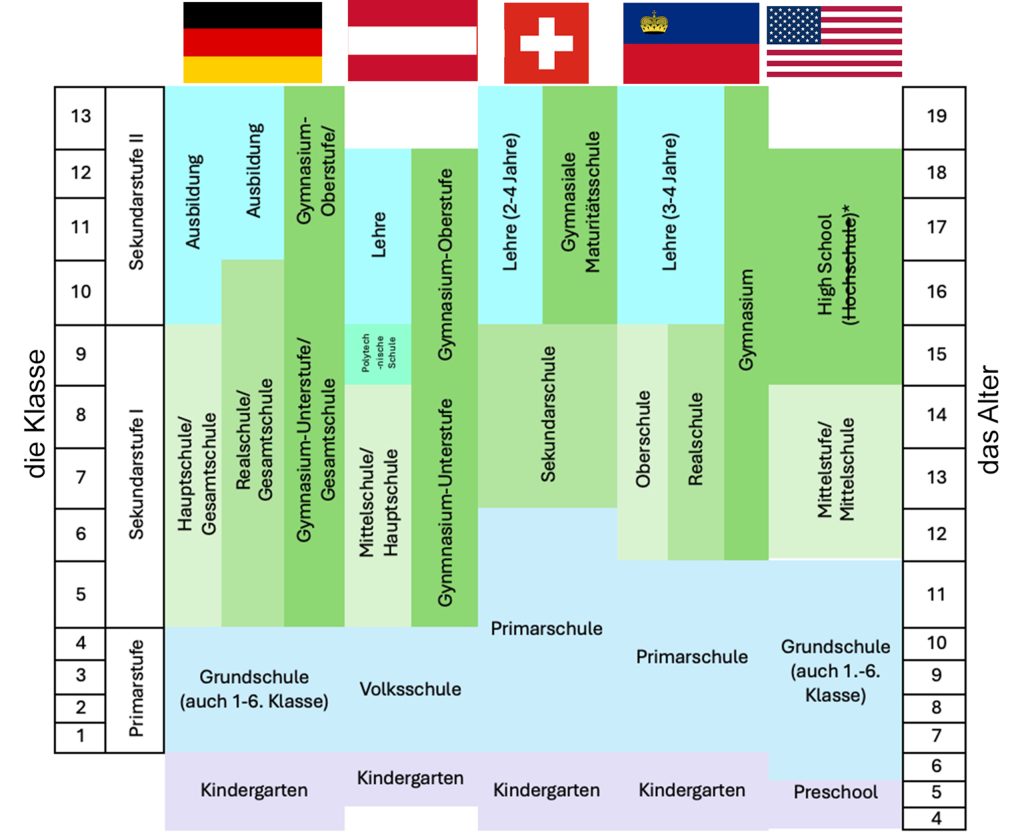 This is a simplified overview of the various school systems in German-speaking Europe. As you can see, school starts with first grade. What we call preschool is called Kindergarten in the German context and Kindergarten is decidedly not school. It is a time of play and socialization and lasts between 2-3 years. The people working there with the children are not called Lehrer*innen (teachers), but Erzieher*innen (childcare worker, educator).
This is a simplified overview of the various school systems in German-speaking Europe. As you can see, school starts with first grade. What we call preschool is called Kindergarten in the German context and Kindergarten is decidedly not school. It is a time of play and socialization and lasts between 2-3 years. The people working there with the children are not called Lehrer*innen (teachers), but Erzieher*innen (childcare worker, educator).
When talking about the US school system in German, we typically use Grundschule for elementary school and then either die Middle-School or some translation like Mittelstufe or Mittelschule. High school is die High School, not the translated Hochschule, because that is another word for a post-secondary place of education (it is a kind of university). With the exception of the word Hochschule, the word Schule is otherwise never used in the university context. Another linguistic difference between the languages can be found in the words for the children at the different stages. Although English has the word pupil for primary and secondary education, in the US, at least, most children in school (and perhaps also in daycare and preschool) are called students. The designation Student*innen (nowadays referred to as the gender neutral Studierende) are terms used solely for people working toward a BA, MA, or PhD. All children in grades 1-13 (1.-13. Klassen) are called Schüler*innen. Those in trade school are called Berufsschüler*innen. Children in Kindergarten are called Kindergartenkinder or just Kinder.
Where we can see the biggest differences between the US and the German-speaking countries in secondary education. While we often split children off into advanced or remedial subject-specific groups or classes, commonly already in elementary school, abroad, the children stay in one group until the end of primary school. Then they are split into two or three different kinds of schools. The finishing degree for each school serves a specific purpose. Only the Abschluss (degree) from the gymnasialen Maturitätsschule (in der Schweiz) and Gymnasium (in Deutschland, Österreich, und Liechtenstein), allow graduating pupils to attend university or other post-secondary institutions of higher education. This Abschluß is called Matura in der Schweiz, Österreich, and Liechtenstein and Abitur in Deutschland. The other finishing Abschlüsse can allow those graduating pupils to attend the next level of schooling (e.g. in Germany, with the Hauptschulabschluss, one could continue one’s education at the Realschule).
Unlike in the US, the goal for most school children is not to attend university. Instead, each country has a very robust Lehr– oder Ausbildungssystem (system of apprenticeships) which allows most pupils to earn a training certificate and title that are financially and socially meaningful. The 2nd year spring semester course covers post-secondary education in greater depth.
Click on the plus signs to read about the different schools in German. See if you can figure out which information in German matches with the information in the previous paragraphs.
How much do you remember? Without looking back at the image or text above, mark all of the words that refer to a kind of school. You can also listen to the text.
Again, without checking, put the schools in the right order from youngest to oldest pupils.
Deutsch IRL and other
- Inklusive Bildung in Deutschland: Dabei sein ist nicht alles, short texts and audio about inclusion in the classroom.
- Der Wechsel vom deutschen ins schweizerische Schulsystem
- DaZPod episode Die Richtige Schule finden, The decision which secondary school a child should go to is very important in Germany. Heike and Clemens discuss the advantages and disadvantages of various schools. Does their son Leo also get a say in this too? This episode revolves around the German school system and its very specific challenges.
- Here’s a Meet the Germans video about the German school system.
- Click here for an interactive video about schools in Germany.
Jetzt bis du dran!
This Jetzt bist du dran! is a bit different. You’ll have your typical question to answer, but you’ll also be prompted to look something up and play with AI a bit.
Auf welche Schulen bist du gegangen? Answer the question in your written journal, inferring from the question what structures you will need. Then record your answer in your audio journal.
Now go back to the image of the school systems and pick the kind of school that interests you the most. Look up information about that kind of school. For a challenge, look up German sources only. (If you pick a school form that is not in Germany, be sure to add the country. The internet is biased to think that all questions in/about German-language things are about Germany.) Jot down some of the most interesting things you’ve learned. If you want to challenge yourself, then write your notes in German. You can begin your sentence with, Ich habe gelernt, dass…
Finally, open your favorite AI and ask it to tell you something about the school form (and country!) you’ve chosen in 1) English and then 2) in German. Once you have your response in German, prompt it to retell you the information in “Intermediate Low” German. Read the responses one-by-one in an order of your choosing. What order makes the most sense to you? When you are reading the English version, does the AI tell you something different from what you learned on your own search? When you are reading the German versions, does the Intermediate Low German version feel much easier than the other? Is it still very hard to understand? If so, you can prompt the AI to retell the same information at a “Novice High” level. Or, if it feels too easy (but the other one feels too hard), prompt it to retell the information at “Intermediate Mid” or “Intermediate High”. When you are done, take some notes for yourself about what you learned about the school form and about AI in your written journal.
Lausanne im Blickpunkt
Lausanne ist die viertgrößte Stadt der Schweiz und die zweitgrößte im französischsprachigen Teil der Schweiz. In der Stadt leben ungefähr 140.000 Menschen. Sie liegt am Genfersee und wurde auf drei Hügeln gebaut. Deshalb ist Lausanne eine sehr hügelige Stadt.
Lausanne is the fourth-largest city in Switzerland and the second-largest in the French-speaking part of Switzerland. Approximately 140,000 people live there. It is located on Lake Geneva and was built on three hills. Therefore, Lausanne is a very hilly city.
2) Wortschatz: Schule
As you can imagine, there are many words one could learn to talk about school. This section will introduce you some of the items you may have had (or still have!) in your backpack to be ready for school. Click through the following presentation, listen to the audio, and read aloud. Then practice your recall.
Want more practice? Match the images to the words.
Deutsch IRL and other
- Click here for an interactive video to practice singular and plural school items.
- Meine Schultasche, short texts about and images of schoolchildren showing what is in their schoolbags.
- Mein Klassenzimmer, short texts about and images of classrooms.
Kleiner Hinweis
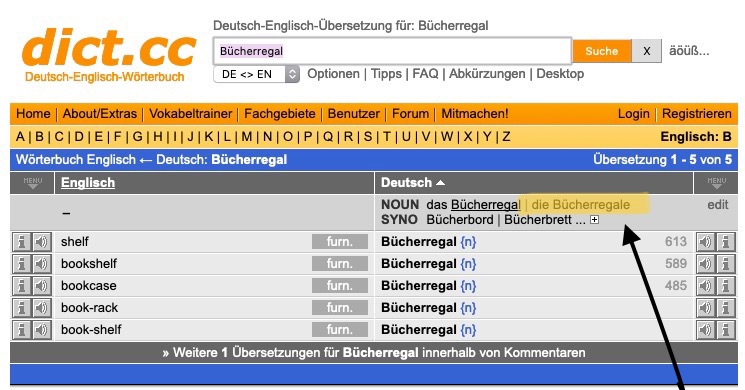
In English, most plurals are formed by adding an “-s” or “-es” to the noun (e.g., students, classes, pens), although there are some irregular plural forms in English (e.g., women, children, geese).
Forming the plural of nouns in German is a bit more complicated than in English. There are several rules one could memorize, but that wouldn’t account for the exceptions. We recommend that you learn the plural form of each noun when you are learning the noun itself: das Bücherregal, die Bücherregale.
Some dictionaries (like dict.cc as shown in the screenshot) write out the plural forms. Other dictionaries only indicate the plural form by abbreviations; you need to understand how to form a plural when you see those abbreviations, for example:
die Lampe, -n (this means: you just add -n to the noun; die Lampen is the plural form)
das Fenster, – (this means: you don’t add an ending to the noun; die Fenster is the plural form)
die Mutter, -¨ (this means: you don’t add an ending to the noun, just the Umlaut on the vowel; die Mütter is the plural form)
Jetzt bist du dran!
Was gibt es in deinem Rucksack? Was gibt es in deinem Mäppchen? Answer the questions in your written journal, using the language modeled in the activities.
Then record your answers in your audio journal.
3) Die Einschulung
 As you now know, children begin school with the erste Klasse (first grade) in German-speaking countries. This school start is called the Einschulung. Listen to and read along with the following text about die Einschulung. Then answer the questions.
As you now know, children begin school with the erste Klasse (first grade) in German-speaking countries. This school start is called the Einschulung. Listen to and read along with the following text about die Einschulung. Then answer the questions.
Die Einschulung in Deutschland ist ein bedeutender Schritt im Leben eines Kindes. In der Regel ist das Kind 6 oder 7 Jahre alt, wenn es eingeschult wird. An diesem besonderen Tag, der oft mit einer großen Feier verbunden ist, tragen die Kinder eine sogenannte Schultüte. Diese bunte Tüte ist mit Süßigkeiten, kleinen Geschenken und Schulmaterialien gefüllt. Die Tradition der Schultüte ist sehr alt. Die gibt es seit dem Ende des 18. Jahrhunderts.
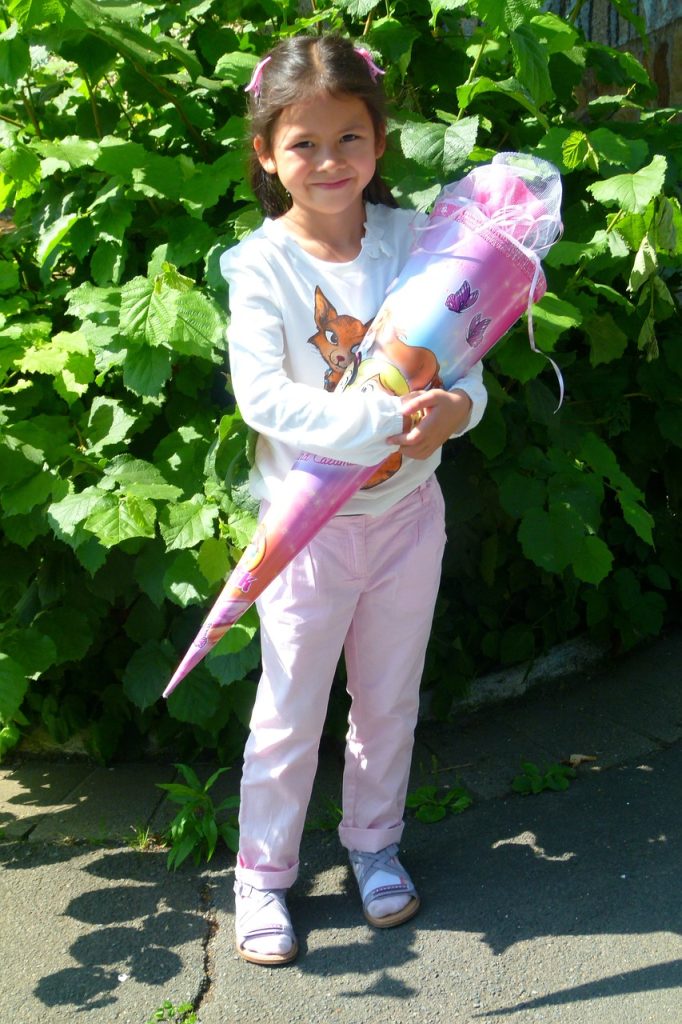 Der erste Schultag selbst ist meist sehr aufregend. Die Kinder lernen ihre neuen Lehrer*innen und Klassenkamerad*innen kennen und erleben eine kleine Zeremonie. In vielen Bundesländern gibt es auch eine Begrüßungsfeier, bei der die Schulleitung und ältere Schüler die Neulinge willkommen heißen. Oft reist die erweiterte Familie wie Großeltern, Tanten, Onkeln, Cousins und Kusinen sowie Patentanten und Patenonkeln an, um die Einschulung mit dem Kind zu feiern.
Der erste Schultag selbst ist meist sehr aufregend. Die Kinder lernen ihre neuen Lehrer*innen und Klassenkamerad*innen kennen und erleben eine kleine Zeremonie. In vielen Bundesländern gibt es auch eine Begrüßungsfeier, bei der die Schulleitung und ältere Schüler die Neulinge willkommen heißen. Oft reist die erweiterte Familie wie Großeltern, Tanten, Onkeln, Cousins und Kusinen sowie Patentanten und Patenonkeln an, um die Einschulung mit dem Kind zu feiern.
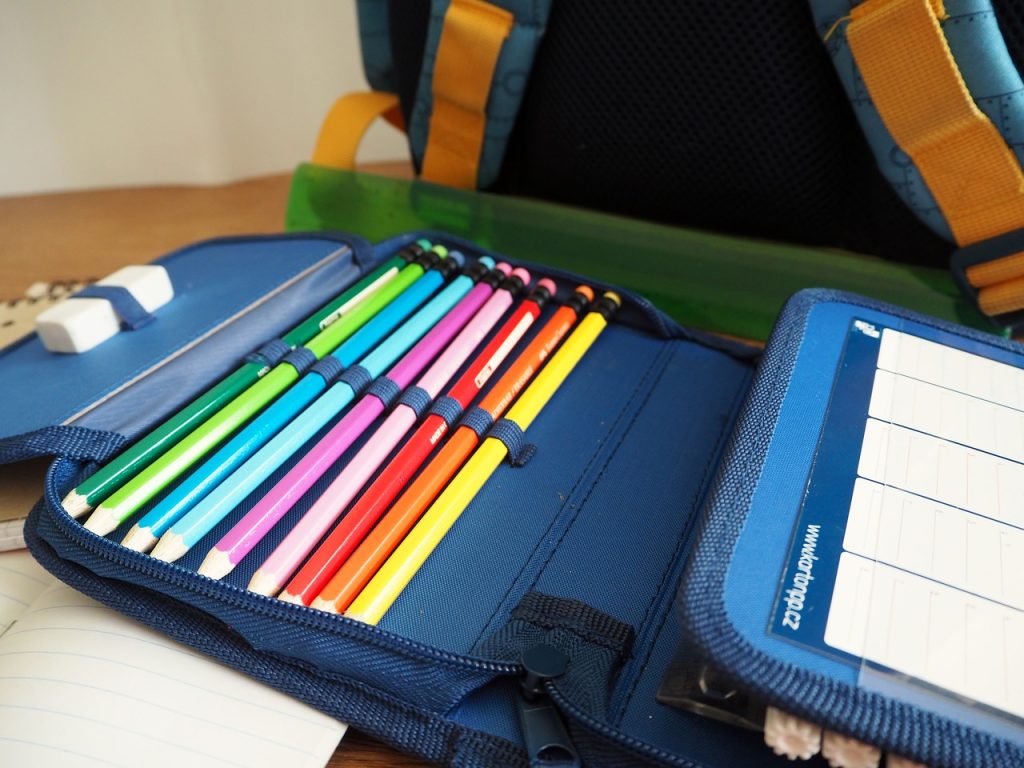
Die Einschulung ist nicht nur für die Kinder, sondern auch für die Eltern ein wichtiger Moment. Sie sind stolz auf die Fortschritte ihrer Kinder und freuen sich auf die kommenden Jahre in der Schule. Die Einschulung markiert den Beginn einer neuen Lebensphase, in der die Kinder viel lernen und neue Freundschaften schließen werden.
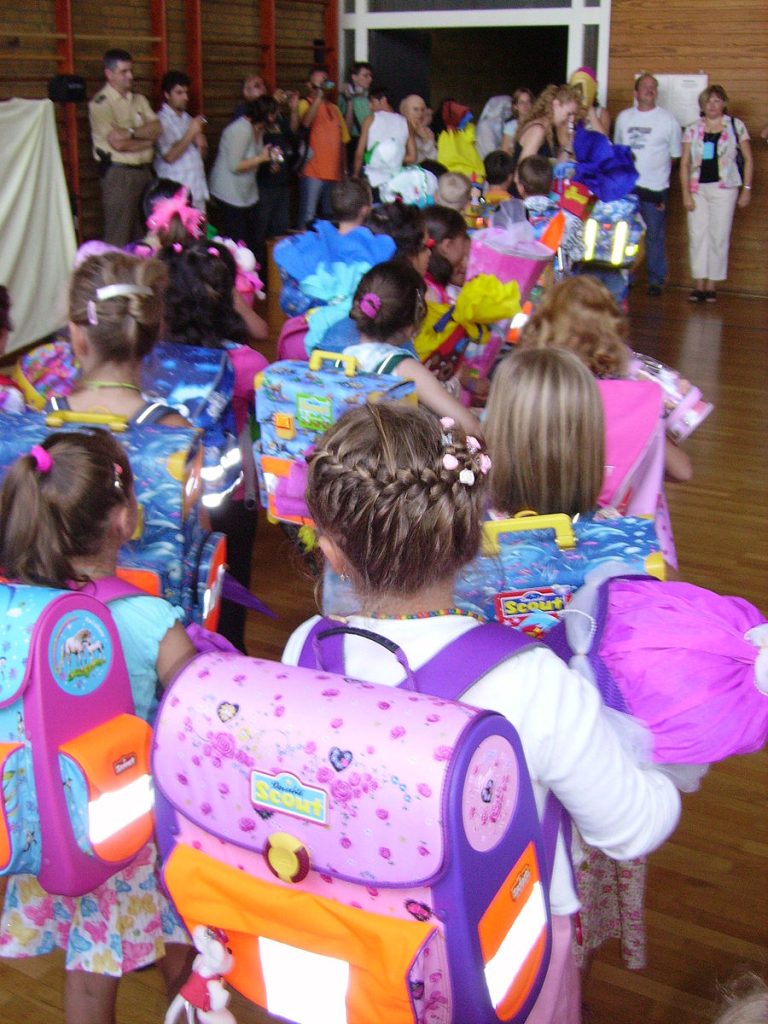
In den anderen deutschsprachigen Ländern wird die Einschulung normalerweise mit weniger Aufwand betrieben. Vor allem ist die Schultüte ein ursprünglich rein deutscher Brauch, der sich langsam auch in den anderen Ländern verbreitet. Nicht alle Schweizer, Liechtensteiner und Österreicher finden diesen Brauch gut, weil er die Klassenunterschiede stark aufzeigen kann, wenn manche Kinder überfüllte Schultüten mit teuren Geschenken wie Videospielen bekommen und andere Kinder nur Bleistifte und Hefte. Auch wird in Deutschland über diese Problematik nachgedacht.
Deutsch IRL and other
- In der Schule, short text with reading comprehension questions about the first day of school.
- Deutsch IRL: Schulanfang Erstklässler (1961) | SRF Archiv, 6m
- Wie der Schulanfang in Deutschland gefeiert wird, Deutsche Welle Article and slideshow
- Schultüten – ja oder nein?
- Die Schultüte hält in der Schweiz Einzug
- Kunterbunter Schulstart
Jetzt bist du dran
Wie war deine Einschulung? Wie alt warst du? Gibt es irgendwelche Traditionen für den Schulanfang in deiner Familie? Answer the questions about your first day of school in your written journal, using the language modeled above. Remember to stick with the German you know, instead of translating word-for-word.
When you are done, check your spelling and structures, then record your answer in your audio journal.
Jetzt kombinieren
In this lesson, you learned about 1) the German-speaking school systems in comparison to your own, 2) words for the classroom and school supplies, and 3) traditions around the school start. Now it’s time to combine your knowledge!
You are on your study abroad to a German-speaking country and you are on a walk with your new friend, when you notice a large gathering of people in front of Grundschule (you can see the sign). The children are carrying large backpacks and holding large, colorful cones. You ask your friend about this interesting sight, which makes your friend curious about American Einschulungstraditionen.
In your written journal, write out a brief dialogue between you and the friend. What questions do you ask? How does the friend answer. What questions does the friend ask? How do you answer? You may be very tempted to write this in English first and then translate it. Resist that temptation! Remember that your conversation does not need to be precise. You cannot sound like you have been speaking German your whole life, when you have only been speaking it for a couple years. Use the German you know and the language modeled here.
When you are done, record your dialogue. As always, feel free to meet up with a classmate and record together.

Media Attributions
- School systems activities adapted from Grenzenlos Deutsch, licensed under CC BY-NC-SA 4.0 International license.
- Kleiner Hinweis on plurals in dictionaries adapted from Willkommen: Deutsch für alle, Copyright © 2020 by Claudia Kost and Crystal Sawatzky, licensed under the CC BY-NC-SA International License 4.0.
Media Attributions
- 2030-2040 ch banner reduced size
- die schulsysteme im vergleich
- schultuete 1917 school-child-526350_1280
- schultuete mit kind school-enrollment-1001489_1280
- maeppchen back-to-school-2680730_1280
- 900px-Einschulung_Schulranzen © Immanuel Giel is licensed under a CC BY-SA (Attribution ShareAlike) license

